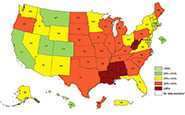Adult Obesity Facts

Obesity Prevalence Maps
Adult obesity prevalence by state and territory using self-reported information from the Behavioral Risk Factor Surveillance System.
Obesity is common, serious and costly
- More than one-third (36.5%) of U.S. adults have obesity. [Read CDC National Center for Health Statistics (NCHS) data brief PDF-704KB]
- Obesity-related conditions include heart disease, stroke, type 2 diabetes and certain types of cancer, some of the leading causes of preventable death. [Read guidelines]
- The estimated annual medical cost of obesity in the U.S. was $147 billion in 2008 U.S. dollars; the medical costs for people who have obesity were $1,429 higher than those of normal weight. [Read summary]
Obesity affects some groups more than others
[Read abstract Journal of American Medicine (JAMA)]
- Non-Hispanic blacks have the highest age-adjusted rates of obesity (48.1%) followed by Hispanics (42.5%), non-Hispanic whites (34.5%), and non-Hispanic Asians (11.7%). Obesity is higher among middle age adults age 40-59 years (40.2%) and older adults age 60 and over (37.0%) than among younger adults age 20–39 (32.3%).
Obesity and socioeconomic status
[Read CDC National Center for Health Statistics (NCHS) data brief [PDF-1.07MB]
- Among non-Hispanic black and Mexican-American men, those with higher incomes are more likely to have obesity than those with low income.
- Higher income women are less likely to have obesity than low-income women.
- There is no significant relationship between obesity and education among men. Among women, however, there is a trend—those with college degrees are less likely to have obesity compared with less educated women.
Related Links
-
Obesity Prevalence Maps
State-specific data on adult obesity prevalence using self-reported information from the Behavioral Risk Factor Surveillance System (BRFSS) shows that obesity prevalence remains high in the United States.
- Page last reviewed: August 29, 2017
- Page last updated: August 29, 2017
- Content source:


 ShareCompartir
ShareCompartir